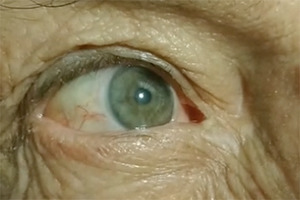
History: A 65 year old male with HTN presented to the ED with a 1-week history of progressive SOB. On physical examination, BP 140/62 mm Hg, HR 120 bpm, RR 30, and SP02 92% on 3L of O2 by nasal cannula. The cardiac examination was notable for a crescendo–decrescendo systolic murmur and a decrescendo diastolic murmur. The ophthalmologic examination revealed dilation and constriction of the pupils, synchronized with the patient’s heartbeat. What’s the diagnosis?
Answer: Landolfi’s sign is seen in patients with severe aortic regurgitation and is a manifestation of wide pulse pressure and large stroke volume in the iridial vessels, which causes systolic constriction and diastolic dilation of the pupils. Transthoracic echocardiography revealed severe aortic regurgitation with dilatation of the ascending aorta and a dissection flap. CT scan of the aorta showed a Stanford type A aortic dissection. The patient underwent the replacement of his ascending aorta and aortic valve (Bentall procedure). On discharge 10 days later, Landolfi’s sign was no longer present.